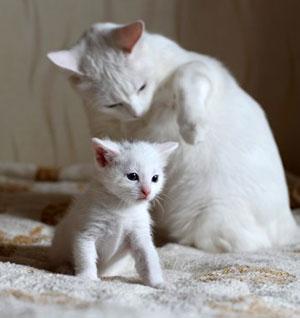This content is archived from the Feline Nutrition Foundation
How Toxoplasmosis Affects Cats
- Updated: Wednesday, May 01, 2019 04:30 PM
- Published: Saturday, August 10, 2013 12:08 PM
- Written by Guillermo Díaz. MV
 My cat occasionally eats mice she catches outdoors, so I worry that she might be exposed to toxoplasmosis. I know about the dangers to humans from toxoplasmosis, but is it dangerous to my cat, too? Would I even be able to tell if she got it?
My cat occasionally eats mice she catches outdoors, so I worry that she might be exposed to toxoplasmosis. I know about the dangers to humans from toxoplasmosis, but is it dangerous to my cat, too? Would I even be able to tell if she got it?
Wild and domestic felines are the only definitive hosts for the toxoplasmosis parasite. Both phases of toxoplasma gondii, sexual and asexual, occur in cats; it's the reason why felines are the main reservoir of the disease. The rest of the non-feline, warm-blooded animals are known as intermediate hosts. Toxoplasma gondii is present all over the world. Cats can get toxoplasmosis when they ingest infective cysts. This can happen from eating raw infested meat or wild prey such as mice or birds. Many cat owners are concerned that their felines will get toxoplasmosis through store-bought meat, but that is unlikely to happen because of all the sanitary and veterinary inspections that cattle and other meat animals undergo pre and post-slaughter.
Generally, the infection in cats is asymptomatic and goes unnoticed by owners. However, when disease does occur, it may develop when the cat's immune response is not adequate to stop the spread of tachyzoite forms. The disease is more likely to occur in cats with suppressed immune systems, including young kittens and cats with FeLV, the feline leukemia virus or FIV, the feline immunodeficiency virus. The most common symptoms of toxoplasmosis infection are fever, loss of appetite and lethargy. Other symptoms may occur depending on whether the infection is acute or chronic, and where the parasite is found in the body. In the lungs, toxoplasma infection can cause pneumonia, which will cause respiratory distress.
 Cats that do get toxoplasmosis develop immunity for life. This means that they will never get and develop toxoplasma infection again in their lives. Many people are scared when their kitty renders a positive result when tested. There is one thing I have to stress, this does not mean that your cat is sick. It only means that she had toxoplasmosis at one point in her life or this simply shows the maternal antibodies passed from the queen into her kittens.
Cats that do get toxoplasmosis develop immunity for life. This means that they will never get and develop toxoplasma infection again in their lives. Many people are scared when their kitty renders a positive result when tested. There is one thing I have to stress, this does not mean that your cat is sick. It only means that she had toxoplasmosis at one point in her life or this simply shows the maternal antibodies passed from the queen into her kittens.
In humans, becoming infected with toxoplasma gondii is only considered dangerous if infection happens during pregnancy. It depends on the immune system of the mother and the stage of the fetus when infection occurs. During the first trimester, the likelihood for the embryo to develop neurological toxoplasmosis is higher than if infected at the end of the pregnancy. In cats, a queen infected with toxoplasma gondii during pregnancy will generally have abortion of the litter or the kittens will be stillborn.
The diagnosis of toxoplasmosis in cats may be established by the same serological tests used in people: polymerase chain reaction, called PCR, histological demonstration of the parasite and/or its antigens, i.e. immunoperoxidase stain, or isolation of the organism. The most used of these tests is the measurement of antibodies in blood.
The end result is that, as in humans, infection with toxoplasma gondii will likely cause no symptoms at all in your cat. If your cat tests positive for toxoplasma gondii, you should not be overly concerned about catching it from your cat. There are two ways by which people can get toxoplasmosis, direct and indirect:
Direct
 For this to happen, it is necessary that several events occur at the same time:
For this to happen, it is necessary that several events occur at the same time:
- The infection must be recent. The cat will begin to shed oocysts between 3 to 10 days after ingestion of infected meat, and continue to shed oocysts for 10 to 14 days. It is rare for a cat to shed oocysts after this period, as an immune response develops.¹
- The cat litter tray is not cleaned on a daily basis. The parasite on the feces must be in sporulating phase. This takes 1 to 5 days from the time the feces is eliminated.
- The person must ingest these sporulating forms. This means the ingestion of fecal material. This may be rude, but it's true.
Indirect
Ingestion of undercooked meat or ingestion of vegetables not properly cleaned.
Additional Reading
Answers: Raw Food and Outdoor Cats, What About Worms?
Spooked By Salmonella: Raw Cat Food!
The indirect method of infection is by far the most common. Getting it directly from your cat is actually rather difficult and requires some questionable hygiene practices on the part of the human. Having said all of that, we can conclude that there is no reason at all to get rid of your beloved kitty if she is infected, even if you're pregnant or will be. Keeping healthy hygiene habits such as cleaning the cat litter on a daily basis and washing hands thoroughly is enough to prevent direct infection. But in all things medical, your doctor must be consulted.Note: Feline Nutrition provides feline health and nutrition information as a public service. Diagnosis and treatment of specific conditions should always be in consultation with your own veterinarian. Feline Nutrition disclaims all warranties and liability related to the veterinary advice and information provided on this site.
Dr. Guillermo Díaz and family, including their four dogs (Leroy, Xica, Moza and Pepa) and six cats (Michalina, Tigger, Vladimir, Yellow, Mongo and Chirusa) moved to Buenos Aires, Argentina in July of 2017, where he expects to continue supporting different animal rescue groups, spread the benefits of raw food for cats and dogs and write articles about nutrition.
1. Astrid M Tenter, Anja R Heckeroth and Louis M. Weiss, "Toxoplasma Gondii: From Animals to Humans," International Journal for Parasitology Vol 30, Nov 2000, Issue 12-13, 217-258.




